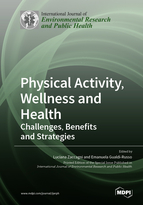Physical Activity, Wellness and Health: Challenges, Benefits and Strategies
A special issue of International Journal of Environmental Research and Public Health (ISSN 1660-4601). This special issue belongs to the section "Health Behavior, Chronic Disease and Health Promotion".
Deadline for manuscript submissions: closed (30 April 2021) | Viewed by 78070
Special Issue Editors
Interests: nutrition; sports sciences; motor learning; biomechanics; anthropometry; physical fitness; sports and performance; wellbeing; motor development
Special Issues, Collections and Topics in MDPI journals
Interests: nutrition; physical activity; obesity; exercise and health; body composition; body image perception; native and migrant populations
Special Issues, Collections and Topics in MDPI journals
Special Issue Information
Dear Colleagues,
Regular physical activity is both a preventive measure and a cure for non-communicable diseases (NCDs). In addition to these health effects, physical activity improves mental health, quality of life, and well-being (World Health Organization, 2018). Conversely, physical inactivity and sedentary lifestyles have negative impacts on individuals, families, and society.
This Special Issue is designed to provide an interdisciplinary and international forum for reporting the latest findings on topics that include anthropometric determinants of health and performance, physical activity and healthy habits, exercise and diet, exercise and body composition, interventions to promote physical activity for people of all ages, strategies for the implementation of an active life, and the beneficial effects of exercise on metabolic syndrome.
Researchers are invited to contribute novel work to be considered for publication in this Special Issue. Studies using advanced research methodologies will be particularly appreciated. All manuscripts will be examined by specialists in the field, and must be submitted by 15 December 2020 at the latest.
Dr. Luciana Zaccagni
Prof. Dr. Emanuela Gualdi-Russo
Guest Editors
Manuscript Submission Information
Manuscripts should be submitted online at www.mdpi.com by registering and logging in to this website. Once you are registered, click here to go to the submission form. Manuscripts can be submitted until the deadline. All submissions that pass pre-check are peer-reviewed. Accepted papers will be published continuously in the journal (as soon as accepted) and will be listed together on the special issue website. Research articles, review articles as well as short communications are invited. For planned papers, a title and short abstract (about 100 words) can be sent to the Editorial Office for announcement on this website.
Submitted manuscripts should not have been published previously, nor be under consideration for publication elsewhere (except conference proceedings papers). All manuscripts are thoroughly refereed through a single-blind peer-review process. A guide for authors and other relevant information for submission of manuscripts is available on the Instructions for Authors page. International Journal of Environmental Research and Public Health is an international peer-reviewed open access monthly journal published by MDPI.
Please visit the Instructions for Authors page before submitting a manuscript. The Article Processing Charge (APC) for publication in this open access journal is 2500 CHF (Swiss Francs). Submitted papers should be well formatted and use good English. Authors may use MDPI's English editing service prior to publication or during author revisions.
Keywords
- exercise
- wellbeing
- health promotion
- healthy habits
- quality of life
- anthropometry
- sports practice
- malnutrition
- weight status
- chronic diseases







